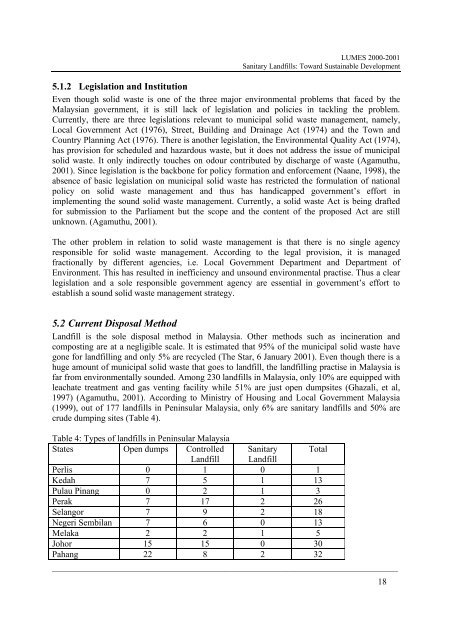Sanitary Landfills: Toward Sustainable Development - lumes
Sanitary Landfills: Toward Sustainable Development - lumes
Sanitary Landfills: Toward Sustainable Development - lumes
You also want an ePaper? Increase the reach of your titles
YUMPU automatically turns print PDFs into web optimized ePapers that Google loves.
LUMES 2000-2001<br />
<strong>Sanitary</strong> <strong>Landfills</strong>: <strong>Toward</strong> <strong>Sustainable</strong> <strong>Development</strong><br />
5.1.2 Legislation and Institution<br />
Even though solid waste is one of the three major environmental problems that faced by the<br />
Malaysian government, it is still lack of legislation and policies in tackling the problem.<br />
Currently, there are three legislations relevant to municipal solid waste management, namely,<br />
Local Government Act (1976), Street, Building and Drainage Act (1974) and the Town and<br />
Country Planning Act (1976). There is another legislation, the Environmental Quality Act (1974),<br />
has provision for scheduled and hazardous waste, but it does not address the issue of municipal<br />
solid waste. It only indirectly touches on odour contributed by discharge of waste (Agamuthu,<br />
2001). Since legislation is the backbone for policy formation and enforcement (Naane, 1998), the<br />
absence of basic legislation on municipal solid waste has restricted the formulation of national<br />
policy on solid waste management and thus has handicapped government’s effort in<br />
implementing the sound solid waste management. Currently, a solid waste Act is being drafted<br />
for submission to the Parliament but the scope and the content of the proposed Act are still<br />
unknown. (Agamuthu, 2001).<br />
The other problem in relation to solid waste management is that there is no single agency<br />
responsible for solid waste management. According to the legal provision, it is managed<br />
fractionally by different agencies, i.e. Local Government Department and Department of<br />
Environment. This has resulted in inefficiency and unsound environmental practise. Thus a clear<br />
legislation and a sole responsible government agency are essential in government’s effort to<br />
establish a sound solid waste management strategy.<br />
5.2 Current Disposal Method<br />
Landfill is the sole disposal method in Malaysia. Other methods such as incineration and<br />
composting are at a negligible scale. It is estimated that 95% of the municipal solid waste have<br />
gone for landfilling and only 5% are recycled (The Star, 6 January 2001). Even though there is a<br />
huge amount of municipal solid waste that goes to landfill, the landfilling practise in Malaysia is<br />
far from environmentally sounded. Among 230 landfills in Malaysia, only 10% are equipped with<br />
leachate treatment and gas venting facility while 51% are just open dumpsites (Ghazali, et al,<br />
1997) (Agamuthu, 2001). According to Ministry of Housing and Local Government Malaysia<br />
(1999), out of 177 landfills in Peninsular Malaysia, only 6% are sanitary landfills and 50% are<br />
crude dumping sites (Table 4).<br />
Table 4: Types of landfills in Peninsular Malaysia<br />
States Open dumps Controlled <strong>Sanitary</strong> Total<br />
Landfill Landfill<br />
Perlis 0 1 0 1<br />
Kedah 7 5 1 13<br />
Pulau Pinang 0 2 1 3<br />
Perak 7 17 2 26<br />
Selangor 7 9 2 18<br />
Negeri Sembilan 7 6 0 13<br />
Melaka 2 2 1 5<br />
Johor 15 15 0 30<br />
Pahang 22 8 2 32<br />
______________________________________________________________________________<br />
18

















